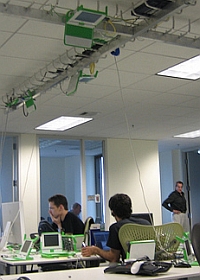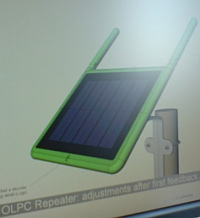I am Aaron Kaplan and I was recently visiting the MIT, home of One Laptop Per Child. I think I have to tell my fellow OLPC News people about the wonderful new solar mesh repeater goodies that are being designed and tested there.
Since I myself come from a background of building and designing free community wireless mesh networks, I was naturally very interested in OLPC's mesh solution. So I was lucky to get a preview of what surprises OLPC might come up with soon.
With my background, one question I had was - "how does OLPC test their 802.11s mesh implementation"? Well, when entering the office, I was quite surprised to see XOs hanging from the ceiling everywhere :) As I discussed with Michail Bletsas, having a moving mesh will actually be something else. But this test setup can already give you a good impression of a school class.
Every XO is connected with a USB-Ethernet connector and thus can be also programmed remotely if the mesh code is not working. The natural tendency is to touch them and explore them, but a "DO NOT DISTURB" sticker reminds you that this is actually a mesh test cluster.
The other thing that immediately hits the eye is the large solar panel on the wall. This solar panel is strong enough to power the gang charger which will be able to recharge the batteries of a school class. The gang charger can furthermore be connected to normal power sockets. So, it seems like going to school will be a nice experience, if you have no electricity at home for some days ;-)
Everybody asks "what happened with the hand crank?" However the hand crank is a bit to fragile. Tests have shown that the force on the mainboard is too big. The hand-power spindle (or salad spinner, or yoyo) is currently undergoing mechanical stability tests and there were still some issues with broken ropes. The current ratio is 1:10. One minue of spinning the spindle = 10 minutes laptop use.
But in Michail's office I was shown something that blew my mind. As said, coming from a background of deploying city wide mesh networks, I knew that this was a big thing.
Take a ~10$ USB 802.11s mesh repeater, observe that it takes very little power and add a solar panel et voila! The cheap solar powered mesh repeater is born! Coming to a lamp post in your neighborhood soon ;)
Of course, there will be still a few technical issues to be solved. Quite a few probably, but... I think again OLPC is showing the way for community wireless networks.
Just check out this OLPC mesh network video from Red Hat:
.



I wonder if there are to be little batteries in those WiFi mesh repeaters so that if there is a lot of sunlight during the day, it would recharge batteries so it can function also overnight.
The display won't be needed for the repeater to run so the standard internal battery would last longer, maybe through the night?
Maybe there's a "repeater" distro that's optimized for the environment and power usage in the repeater role.
Is it possible to wire an external antenna into an XO? Those repeaters might be more useful if the network they set up could span the miles/kilometers between schools but you can't use a directional antenna without an RF connector.
Does anybody know whether the XO can also access standard 802.11 b/g access points?
Roland,
From my understanding, either the mesh standard "s" is backward compatible with b and g by default or Marvell designed the mesh systems to be so natively. Either way, the OLPC XO is b/g and s fluent.
Looks like some of my concerns (surprise!) have been anticipated and acted upon:
http://wiki.laptop.org/go/News#Laptop_News_2007-06-09
Item five seems like it might be a range-extender although what it is isn't exactly clear. Item four lists the OLPC product line-up. One item that appears to be missing is the security server. Does anyone know if that'll be rolled into the school server? Seems like the logical place for it.
In spite of the developing a,b,g,n & now s "alphabet soup" of enhanced 802.11x, boring old 2.4GHz microwave propagation issues are still at work. Unless links are essentially line of sight (LOS) then almost anything metallic or water filled limits range. An immense benefit of USB WiFi client adapters is that even moving them a few metres into a signal "sweet spot" (above head height,office partition,roof line,vegetation or similar obstructions)can yield colossal WLAN performance boosts. This USB feature has been exploited with the celebrated "WokFi" cookware dish antenna => www.usbwifi.orcon.net.nz
In spite of it's 2 "ears" the OLPC WLAN adapter is essentially inbuilt,& hence kids moving around in the room etc will randomly alter weak signal WLAN performance. Such inbuilt adapters are only really useful for strong WiFi signals!
IMHO the bat style hangers noted in the picture immediately imply USB adapters should have been used, as with cheap USB cables the WLAN clients could be neatly run over to a good RF take off spot at a window. It makes no sense to devote/sacrifice a OLPC as just an out of reach indoor ceiling repeater!
EXTRA: Solar powered "b" & "g" repeaters are very well established & extremely sensible in sunny locations. Many commercial APs can also work as repeaters of course & it's now quite routine to rustle up PVs & cheap batteries, the latter often SLA "gel cells". Even a 12V car battery, too weary to crank an engine, can work well.
I raised this issue in a more open ended ideas without specifics to the low power source (instead referencing the "power page") back in January 2007.
http://wiki.laptop.org/go/Wireless_repeater
It's nice to hear there's an experimental lab testing their implementation of it. I still wish someone would create an inexpensive, single chip repeater too. Some additional ideas & considerations can be found at that URL.
Hello Stan,
I checked your site again. Saw it already a few months ago. I love it.
However, you probably will agree that your manufacturing methods however ingenious are not useful for series production. Although your "second hand" components might look cheap if you can pick them up at a junk yard the time you need to collect and build them is prohibitive for series production. Therefore it is clear that OLPC must take a different approach and can still beat your designs for low cost. But your design ideas would be absolutely great for high school students to experiment and learn about high frequency techniques.
For my curiosity: Have you ever tried to do some quantitative testing on your antenna properties like directional power density distribution, focussing angle, efficiency and gain etc.
Testing has been VERY much part of the diverse designs,as the project was intended to stimulate students themselves into trials. We've kept things simple & largely used Netstumbler, with typical results => http://www.usbwifi.orcon.net.nz/lazywifi.jpg
Mass production = even LOWER material costs that we've seen. With our NZ one off costs ~US$5 for a 12" mesh scoop & ~US$2 for fittings etc, I'd say 100 up could be half that each. The design perfectly suits a cottage industry of course! Stan in New Zealand
I've argued for a long time that it would be great to have a variant on OLPC for disaster management, and adding PV as the power source would be icing on the cake.
W. David Stephenson
Stephenson Strategies
http://www.stephensonstrategies.com
Hi -- you're using my "Mesh network testing" photo on this post and the Creative Commons license it has doesn't allow commercial use. Would you mind removing it from the blog and perhaps just linking to it instead? Thanks.
Jessamyn, how does OLPCNEWS.COM count as "commercial use?!"
Jess,
The Fair Use provision of the US Copyright law allows for the use of copyrighted material without requiring permission, for the purposes of criticism, comment, and news reporting, among other actions undertaken to increase public knowledge and discussion - the exact aims of OLPC News. http://www.copyright.gov/fls/fl102.html